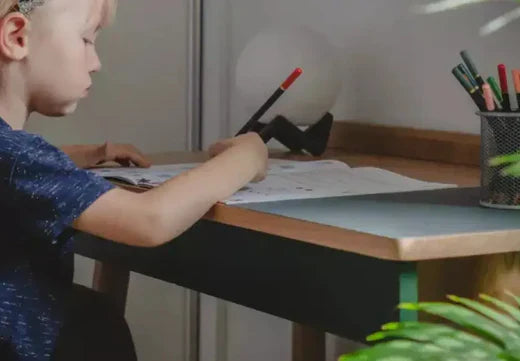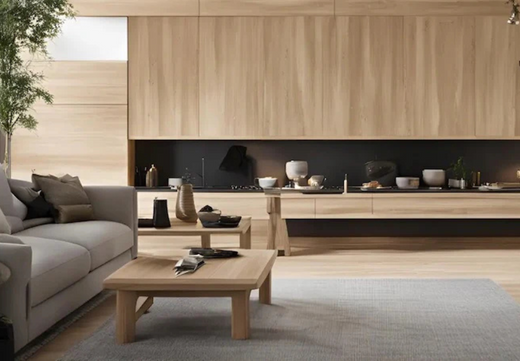Selecting a child's desk is not only a matter of aesthetics but, above all, of health and learning efficiency. When it comes to a child's room, it is especially important that the desk is appropriately tailored to the child's needs and the available space. How to properly arrange a desk in a small child's room? This is a question many parents ask themselves when wanting to create an ergonomic space for their child to study and play. This piece of furniture plays a key role in shaping proper posture, health, and the organization of the workspace, regardless of the room size.
Table of Contents:
- Where to Place a Desk for a Child?
- How to Orient the Desk Relative to the Window?
- How to Properly Arrange the Desk? Arranging the Child's Room.
- Setting Up a Child's Desk. How to Do It?
Where to Place a Desk for a Child?
Choosing the right child's desk should take into account several key aspects that will influence the comfort and functionality of its use. First and foremost, the appropriate height of the desk is crucial – the furniture should be set at a height that allows the child to sit comfortably and write, supporting comfort during study sessions.
Another important factor is the desk's placement relative to a source of natural light. It's worth placing the workspace near a window to ensure adequate lighting, especially during daytime homework. This reduces the need for artificial lighting and improves the child's visual comfort.
Equally important is providing the child with an ergonomic space, both in terms of desk and chair arrangement. Properly arranged furniture helps maintain correct posture, which is vital for the child's health, especially during periods of rapid growth.
Finally, pay attention to the desk's tabletop height and the space underneath. The area should offer enough room for storing books, notebooks, and other school materials, helping to maintain order and facilitate focus on studying.
How to Orient the Desk Relative to the Window?
Proper desk orientation in relation to the window is a key aspect that can significantly affect the comfort of work and study. Positioning it to maximize the use of natural light will improve concentration and reduce eye strain. However, improper placement can lead to issues such as annoying glare on the computer screen, which effectively lowers work efficiency.
Desk Under the Window in a Child's Room – Is It a Good Solution?
A desk under the window in a child's room has its pros and cons. On one hand, access to natural light is a real benefit, especially when the child spends long hours working. Daylight improves mood and supports concentration. On the other hand, such placement can lead to glare on the computer screen, which can be tiring for the eyes.
How to Arrange the Desk to Avoid Glare on the Screen?
When setting up a study area in a child's room, it's important to ensure proper desk placement. Where you place it significantly affects work comfort and eye health. One of the most common problems is glare on the computer or tablet screen. Fortunately, it's easy to avoid.
The best approach is to position the desk at an angle to the window. This way, daylight will enter the room without shining directly on the screen. This simple solution allows the child to focus on studying without the fatigue caused by screen reflections.
If the room is very bright, consider blackout blinds or curtains. They help limit excessive light, especially on sunny days. They are also useful when the child uses a screen in the evening – softer lighting is much better for the eyes.
Also, remember to have a good desk lamp for the child's desk. It should have an adjustable arm to easily direct the light where needed. With such simple tricks, the study area becomes comfortable and welcoming, allowing your child to focus on tasks without unnecessary obstacles.
How to Properly Arrange the Desk? Arranging the Child's Room.
Providing the child with an ergonomic space is the foundation of the child's health and comfort during study sessions. A well-planned space not only supports proper posture but also increases work efficiency.
This is especially important during periods of intense development. Proper arrangement of the child's room, adjusted to their growth, can prevent back problems and reduce muscle fatigue.
Ergonomic Chair – The Key to Proper Posture
Choosing a chair is equally important. What chair should you choose to ensure the child sits correctly? An ergonomic chair with an adjustable seat height and armrests is the ideal solution.
Such a chair supports the spine, helps maintain the correct posture while sitting, which greatly affects the child's health. Combined with the appropriate desk height, an ergonomic chair creates the perfect study space – comfortable and healthy.
Check out the chair that grows with your child.
Desk and Chair Height – How to Adjust to the Child's Growth?
Adjusting the height of the desk and chair to the child's growth is a key element of ergonomics. The appropriate desk height for children ensures a comfortable position for studying, directly affecting comfort and health. To ensure proper posture, keep in mind several principles:
Proper desk placement involves adjusting it to a height where the child can freely rest their feet on the floor. If the feet hang, consider a footrest – this will provide adequate support. The child's elbows should be at the level of the desk or slightly higher, allowing for a natural hand position while writing or working on the computer.
The chair is also crucial. Adjustable models are the best choice because they can easily be adapted to the child's growing height. It is important that the backrest supports the entire length of the spine, and the knees are bent at a right angle. A chair with adjustable seat depth is also a good solution – it provides better support for the thighs.
Remember that proper arrangement not only supports correct posture but also makes the child feel more comfortable. This makes it easier for them to concentrate on studying and avoid fatigue.
Find a desk with adjustable height here.
Lighting for the Child's Desk – Desk Lamp and Blackout Blinds
Good lighting for the child's desk is essential for a comfortable study space. Natural light is ideal, but not always sufficient – especially in the evening or on cloudy days.
In such cases, a desk lamp becomes indispensable. It should provide bright, even light that does not strain the eyes. The best option is a lamp with an adjustable arm, allowing you to easily direct the light where the child needs it. Remember that for right-handed individuals, the light should shine from the left side, and for left-handed individuals – from the right, to avoid creating shadows on the work surface.
If you decide to place the desk under the window in the child's room, blackout blinds can be very convenient. They allow you to easily adjust the amount of incoming light and avoid situations where sunlight reflects off the computer screen or dazzles the eyes. This is especially important at noon when sunlight is most intense. Blinds also help create a pleasant study atmosphere by eliminating contrasts between bright and dark areas in the room.
Good lighting is not just about the lamp or blinds – it’s the whole setup that promotes health and concentration. This ensures that your child has an ideal space where they can work comfortably and effectively.
Setting Up a Child's Desk. How to Do It?
Arranging a desk in a small child's room, where every centimeter matters, requires careful consideration. The key is to make the most of the available space. The aspects of desk arrangement and its location will influence the overall design of the child's room. This way, you can create a space that fosters both studying and playing while not overwhelming the interior.
Corner Desk – Maximizing Space Utilization
Corner desks are an ideal solution for small rooms. They utilize the corner of the room, which often remains unused, creating a comfortable work nook. With this arrangement, you provide the child with enough space to study and store supplies without taking up too much space in the center of the room.
Additionally, you can equip them with shelves above the tabletop, allowing for storage of books or school materials, saving space elsewhere in the room. Corner desks work excellently in small children's rooms, where a separate study zone is needed but there is also a desire to keep space for play and relaxation.
How to Arrange Furniture Directly Under a Bunk Bed?
Bunk beds with built-in desks are a real hit in small spaces. They combine functionality with space-saving, allowing you to conveniently organize both sleeping and study zones in one structure. This solution keeps the room more open, which is important for children who need space for movement and play.
Arranging a child's desk under the bed can be enhanced with cabinets or shelves, providing additional storage space. This solution is especially appreciated by parents of school-aged children who require a well-organized study area while maximizing space in the room.
DIY Child's Desk with a Top – How to Adapt to a Small Space?
Having trouble arranging a child's room? A DIY desk with a top is a creative option for small rooms, where flexibility and individual adjustment are key. A self-mounted tabletop can be attached to the wall, saving space and allowing you to adjust the surface size to the available area.
Arranging the desk near the window is a great way to utilize natural light, which fosters concentration and creates a friendly learning atmosphere. If space is exceptionally limited, consider using a foldable tabletop that takes up almost no space when folded. With such solutions, setting up a child's desk becomes easier. It also allows you to choose materials and colors that perfectly fit the child's room arrangement.
Desk Organizers – How to Maintain Order?
Maintaining order in a small room is particularly important, as every unnecessary item can create chaos. Desk organizers help easily and quickly tidy up the space. These can be simple containers for pens, colorful baskets for books, or sets with drawers for small items.
In arranging a child's room, wall-mounted organizers work excellently – pocket boards or shelves that do not take up space on the tabletop but provide additional storage space. A good idea is also to introduce a color-coding system, which helps the child quickly find the needed items.
With a well-organized desk, the child can better focus and efficiently use the available space.
How to Handle a Large Number of Books and Limited Space?
Managing a large number of books in an apartment can be challenging, especially when space is limited. However, it's important to remember that there are many methods that allow you to effectively organize books, even when space is small. The key to success is choosing the right solutions that save space and maintain order.
If your book collection is constantly growing and the shelves are becoming overcrowded, arranging books in two rows is one of the best ways to optimize space. This solution allows you to fit significantly more books on one shelf, and you can organize them in a way that makes it easy to access your favorite titles.

Arranging books vertically is another way to save valuable space on shelves. This arrangement is especially useful when books are of different sizes. By arranging them this way, books can be better adapted to the shelf size and fit in the available space without duplicating space.
However, if you care about aesthetics but have a really large number of books, consider arranging them flat. This is a great solution if you have a collection of books of similar sizes. Books arranged this way create an even and symmetrical line, making shelves look neat and aesthetic while being functional.
When the number of books starts to exceed the available space, useful tips regarding shelves can also be helpful. There are many practical solutions that allow for better space utilization. For example, consider investing in shelves with adjustable shelf heights to accommodate different book sizes. Additionally, shelves with extra drawers or compartments can help store other items, freeing up space for the books themselves.
One way to effectively arrange books is to combine vertical and flat arrangements. You can place titles vertically in rows and, among them, arrange a few books horizontally. This solution works when you want to save space and organize books of different sizes. Horizontally arranged books can also serve as stabilizing elements for those placed vertically, and they create an interesting contrast that enhances the aesthetics of the shelves. Such a combination of arrangements helps maximize space utilization, and the shelves look both functional and attractive.
In cases where the racks start to become overcrowded, it’s worth seeking useful tips regarding shelving units. There are many practical solutions that allow for better space utilization. For example, consider investing in shelves with adjustable shelf heights to accommodate different book sizes. Additionally, shelves with extra drawers or compartments can help store other items, freeing up space for the books themselves.




